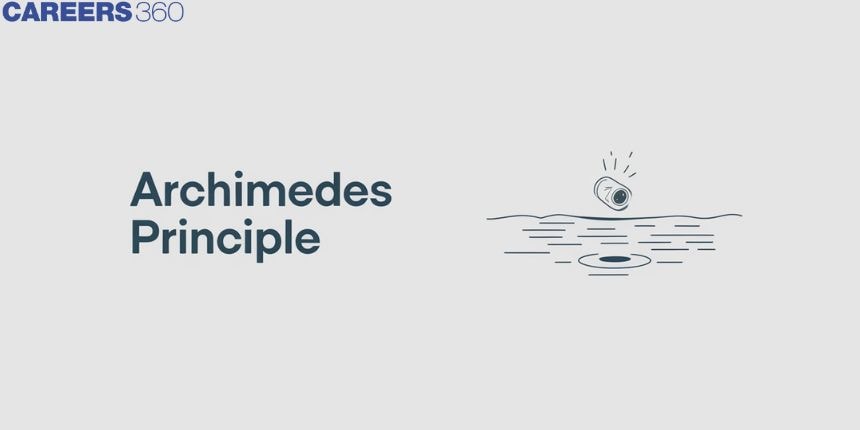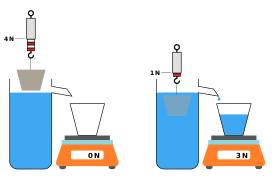Archimedes Principle - Meaning, Experiments, Examples, FAQs
Archimedes’ principle explains why some objects float in water while others sink. It says that when an object is fully or partially placed in a fluid, the fluid pushes it upward with a force called buoyant force. This upward force is equal to the weight of the fluid displaced by the object. If the buoyant force is greater than or equal to the weight of the object, the object will float. If the buoyant force is smaller than the object’s weight, the object will sink. This idea helps us understand boats floating on water, balloons rising in air, and even why we feel lighter while swimming. In this article, you will learn Archimedes’ principle with examples and simple explanations.
This Story also Contains
- What is Archimedes' Principle?
- Apparent Weight
- Explain Archimedes' Principle Derivation
- Archimedes Principle Experiments
- Application of Archimedes Principle
- Solved Example Question

What is Archimedes' Principle?
Any object fully or partially immersed in a fluid experiences an upward force (buoyant force) equal to the weight of the fluid displaced by the object.
Examples:
- A boat floats because it displaces enough water to balance its weight.
- A stone feels lighter in water due to the upward buoyant force.
Also read -
Apparent Weight
The apparent weight of an object is the weight of the body experienced by it when it is submerged in a fluid. When a body is placed in a fluid, it experiences an upward push (buoyant force), which reduces the downward pull and makes the object feel lighter than its actual weight. If an object is floating on the surface then it weight feels almost negligible.
Let's understand the phenomenon by an example:
When you have a big stone in water, its weight is lighter than when you experience it on land. This is because water offers a buoyant force(upthrust) making an object feel lighter.
Apparent weight = Actual weight - Buoyant force
Explain Archimedes' Principle Derivation
The idea is based on the buoyancy principle, which asserts that any item fully or partially immersed in a gas or liquid can exert an upward pull on it. The buoyant force refers to the upward thrust.
A cylinder of height h and radius r is immersed vertically in a liquid in the diagram above, with its flat surfaces at depths h1 and h2, and h1 < h2. At each point on the cylinder's surface, the liquid exerts a perpendicular thrust (pressure). The net thrust on the curved surface is zero due to axial symmetry. The downward pressure on the upper flat surface is h₁ρg, where g is the gravitational acceleration and ρ is the density of the liquid.
$h_2 \rho g$ of upward pressure is exerted on the bottom flat surface. The downward force on the upper surface, if the air pressure is Patm, is
$
F_1=\left(P a t m+h_1 \rho g\right) \pi r^2
$
On the bottom surface, the upward force is,
$
F_2=\left(P a t m+h_2 \rho g\right) \pi r^2
$
The resultant force on the cylinder is upward and the magnitude is, since $\mathrm{h} 1<\mathrm{h} 2$
$
\begin{aligned}
& \mathrm{Fb}=\mathrm{F}_2-\mathrm{F}_1 \\
& \mathrm{Fb}=\left(\mathrm{h}_2-\mathrm{h}_1\right) \rho \mathrm{g}_1 \mathrm{r}^2
\end{aligned}
$
The upward thrust can be stated as, where $\mathrm{h}=\mathrm{h} 2-\mathrm{h} 1$ is the cylinder's height and $V=\pi r^2 h$ is its volume.
$
\mathrm{Fb}=\rho \mathrm{V} g
$
The weight of liquid of equal volume V as the submerged object is the right-hand side of this upthrust Archimedes principle formula. The buoyant force, on the other hand, has the same magnitude as the apparent weight loss of the object. As a result, the apparent drop in object weight equals the weight of the fluid displaced by the object.
|
Related Topics, |
Archimedes Principle Experiments
-
Fill a cup to the full with water and set it in an empty dish.
-
Now, grab whatever solid object you want and weigh it with a spring balance. Make a note of it.
-
Submerge the object in the water while it is still attached to the spring balance. Simply ensure that the spring balance is not immersed.
-
Take note of the weight displayed by the spring balance now. You'll notice that it's decreased. A certain amount of water will be displaced into the bowl.
-
Collect and weigh this water. You'll notice that the weight loss of the object is exactly equal to the weight loss of the water!
Law of Floating-
The magnitudes of the object's real weight W1 and the buoyant force W2 exerted by the fluid determine whether an immersed object will float or sink.
-
W1 > W2: The object's resultant force is downward, causing it to sink. This condition occurs when the object's density is larger than the fluid's density.
-
W1 = W2: The real weight and buoyant force are similar when the densities of the object and the fluid are equal. In a totally immersed state, the object can float at any depth.
-
W1 <W2: The net force works in an upward direction, causing the object to be partially submerged. In such instances, the object's density is lower than that of the fluid.
Application of Archimedes Principle
The Archimedes principle has the following applications:
-
Submarines remain completely submerged because of the ballast tank. The ballast tank is the part of the submarine that is filled with water and makes it heavier. This weight makes the submarine heavier than the buoyant force acting on it and keeps it submerged.
-
Hot-air balloon: Because the buoyant force of the hot-air balloon is less than that of the surrounding air, hot-air balloons rise and float in mid-air. When the hot-air balloon's buoyant force is greater, it begins to drop. This is accomplished by adjusting the amount of heated air in the balloon.
-
A hydrometer is a device that is used to determine the relative density of liquids. The hydrometer is made up of lead bullets that float vertically in the liquid. The deeper the hydrometer sinks, the lower the liquid density.
Solved Example Question
Q.1 A solid metal ball weighs 40 N in air. When fully immersed in water, its weight becomes 30 N . What is the buoyant force acting on it?
Solution:
Buoyant force $=$ Weight in air - Weight in water
$
=40 \mathrm{~N}-30 \mathrm{~N}=10 \mathrm{~N}
$
Answer: 10 N
Q.2 A block displaces $0.02 \mathrm{~m}^3$ of water. What is the buoyant force? (Take density of water $=1000 \mathrm{~kg} / \mathrm{m}^3, \mathrm{~g}= 10 \mathrm{~m} / \mathrm{s}^2$ )
Solution:
Buoyant force $=$ Weight of displaced fluid
$
F=\rho V g=1000 \times 0.02 \times 10=200 \mathrm{~N}
$
Answer: 200 N
Q.3 A wooden object floats with $25 \%$ of its volume above water. What does it tell about its density?
Solution:
Fraction submerged $=75 \%$
Density of wood $=0.75 \times$ density of water
$
=0.75 \times 1000=750 \mathrm{~kg} / \mathrm{m}^3
$
Answer: Density of wood $=750 \mathrm{~kg} / \mathrm{m}^3$
Frequently Asked Questions (FAQs)
According to Archimedes' principle, an item totally or partially submerged in a fluid feels an upward buoyant force equal to the force of gravity on the displaced fluid.
The Archimedes principle was discovered by Greek mathematician Archimedes.
Archimedes continued his investigations and developed the buoyancy principle, which states that a ship would float when the weight of the water it displaces equals the weight of the ship and that anything can float if it is shaped to displace its own weight of water before submerging.
Ships and submarines are designed with the Archimedes principle in mind. The principle of Archimedes is used in hydrometers.
The buoyant force on a submerged object is equal to the weight of the fluid displaced. The average density of the object is calculated by dividing the mass by the volume determined thus far.
